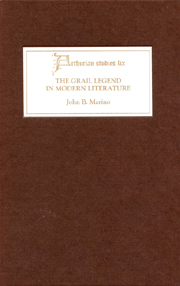Book contents
CONCLUSION
Published online by Cambridge University Press: 12 September 2012
Summary
The New Age movement tries to do everything with the Grail. It is both a Christian and pagan legend, more pagan than Christian, since the origin theories have revealed its prototypes in a Celtic antiquity and Mystery cults that synthesized pagan and Christian traditions. This appeals to a New Age kind of pluralism that strives for inclusiveness in the present by revival of an imagined Golden Age from the remote past. The legend is open to personal interpretation in the manner of a universal metaphor now that skepticism has made an exclusively Christian Grail unacceptable. The focus of the New Age movement is the self, and this subjectivity rules out any representation of a sacred otherworld accessible only through an authoritative religious institution. The Grail becomes an actual spiritual reality that preserves an ancient secret knowledge passed on to twentieth-century mystics. In these ways, the current popular idea of the Grail brings together all three trends in the ongoing development of the legend: an origin controversy used in a culture war between traditional Christian religion and neo-pagan spiritualities, secular humanist transformation of the legend into metaphor because of skeptical rejection of a sacred otherworld, and actualization of the Grail as a spiritual reality accessible through esoteric mysticism.
These developments in the history of the Grail legend are aided by the success of Jessie Weston's From Ritual to Romance, which has a hand in all three trends. Her Mystery cult theory reconciles the competing Christian and Celtic pagan origin theories with a synthesizing belief system inclusive of both Christianity and Celtic paganism.
- Type
- Chapter
- Information
- The Grail Legend in Modern Literature , pp. 149 - 150Publisher: Boydell & BrewerPrint publication year: 2004



